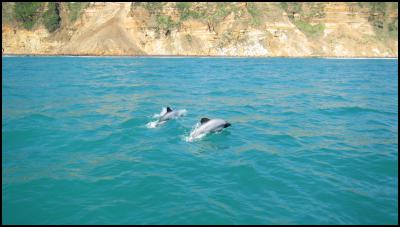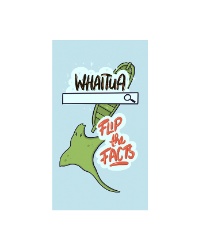Scientists eavesdrop on endangered dolphins

Laura Boren/DOC
Scientists eavesdrop on endangered dolphins
The critically endangered Māui dolphin is getting a helping hand from scientists this month who are beginning a year-long research project to listen in on them.
Latest estimates put the Māui dolphin population between 57 and 65 so scientists want to find out more about them in an effort to improve their chances of survival.
Māui dolphins are only found on the west coast of the North Island, with the greatest concentration between Manukau Harbour and Port Waikato. While they are known to congregate close to shore in water less than 20 metres deep, it is uncertain how far offshore they travel and what risks they might face in doing so.
As part of a collaborative project between the Department of Conservation, the Ministry for Primary Industries and the University of Auckland, NIWA marine ecologists Dr Kim Goetz and Dr Krista Hupman are this month deploying a line of up to nine offshore acoustic moorings stretching from the shoreline to 12m offshore just south of Manukau Harbour.
Each mooring will carry two acoustic devices. A cetacean and porpoise detector (CPOD) will record detections of the high frequency “clicks” the dolphins produce to hunt prey and navigate. The second device, a soundtrap, will record a subset of both clicks and whistles.
Dr Goetz says the first step is to establish how far offshore they can be detected. “Acoustic monitoring provides a reliable way to detect the presence of marine mammals over a long time period. In terms of Māui dolphins, we really know very little about their seasonal movements, offshore distribution, and ultimately why they appear to be confined to this area.
“They are an endangered animal so anything we can contribute to increasing our knowledge will be very useful.”
A photographic survey of Māui dolphins takes place annually, where distinguishing marks and scars are correlated with known animals.
In addition, mark-recapture biopsy surveys to estimate the number of dolphins is conducted across two years, every five years. The last one was completed in 2016 so the next one will begin in 2020. This provides a valuable “snapshot” at a given time, but Dr Goetz says the acoustic survey will add to this data by providing information collected over an entire year.
DOC marine species expert Lauren Boren says the small population size and the nature of the west coast, potting the dolphins can be difficult.
“We’ve been trying to increase our ‘eyes’ on the water by encouraging public sightings of the dolphins, but these acoustic moorings will increase our ‘ears underwater’ and be there listening when we can’t be watching.
Data from the moorings will be retrieved every three months but the project will run for 12 months to enable scientists to detect any seasonal variations.
Māui dolphin, a sub-species of the Hector’s dolphin and the world’s smallest dolphin species, have a rounded black dorsal fin, compared to other dolphins whose fins are shaped like a sickle. They only live for up to 20 years and are slow to breed. Females grow up to 1.7m long and weight up to 50kg – males are slightly smaller and lighter.
The Māui dolphin project follows another acoustic monitoring project Dr Goetz is undertaking in Cook Strait where hydrophones have been placed to detect marine mammals. More than half the world’s whale and dolphin species are found in New Zealand waters yet little is known about their migration paths and behaviour.
Preliminary results from this project have revealed recordings of vocalisations from Antarctic blue whales, minke whales and several different beaked whale species that are rarely seen.
end


 Science Media Centre: Landmark Climate Change Case This Week – Expert Reaction
Science Media Centre: Landmark Climate Change Case This Week – Expert Reaction Stats NZ: Total Greenhouse Gas Emissions Rise 0.9 Percent In The March 2025 Quarter
Stats NZ: Total Greenhouse Gas Emissions Rise 0.9 Percent In The March 2025 Quarter Commerce Commission: ComCom Finds No Evidence Of Cartel Behaviour In Banks’ Involvement In Net-Zero Banking Alliance
Commerce Commission: ComCom Finds No Evidence Of Cartel Behaviour In Banks’ Involvement In Net-Zero Banking Alliance Hāpai te Hauora: Pātea - A World-First Māori Gambling Harm Digital Platform Launches Across Aotearoa
Hāpai te Hauora: Pātea - A World-First Māori Gambling Harm Digital Platform Launches Across Aotearoa Āti Awa Toa Hauora Iwi Māori Partnership Board: New Whaitua Mapping Tool And Monitoring Our Oranga Framework Places Health Information In Whānau Hands
Āti Awa Toa Hauora Iwi Māori Partnership Board: New Whaitua Mapping Tool And Monitoring Our Oranga Framework Places Health Information In Whānau Hands Hugh Grant: How You Know You Need To Get Your Business's Plumbing Checked
Hugh Grant: How You Know You Need To Get Your Business's Plumbing Checked


